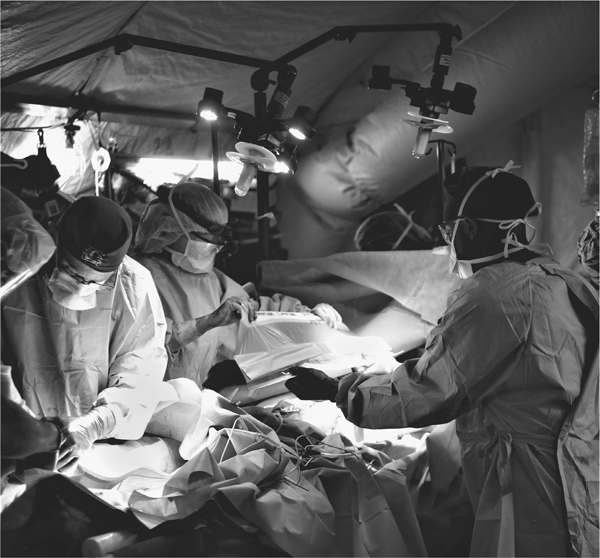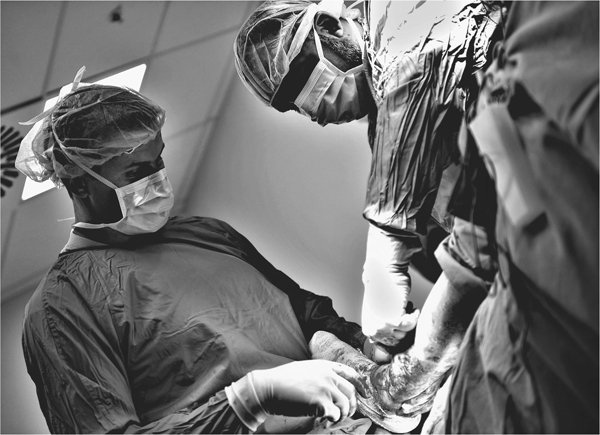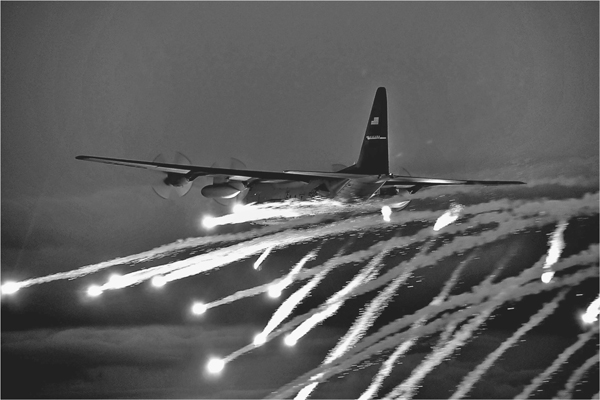Marine in the Helmand
One of the Marines from the command post is beating the hell out of the trauma bell again, which is an oversized cut of rebar someone strung up just outside the tent at the back of our position—known as a forward resuscitative surgical team/shock trauma platoon—a few years ago. It’s the one piece of our medical equipment that never fails. We all stumble grumpily and anxiously out of our tents into the afternoon glare of the Helmand Province in Afghanistan. I hear Sergeant G. two tents down, yelling, “Two Cat Alphas, ten mics out!”
In the front tent that serves as our emergency room, the teams are already in full motion, spiking IV bags and checking oxygen masks at the first two tables. No one is saying much. Everyone knows the drill.
I cut across to our operating tent. The corpsmen are moving fast. They have the instrument sets on the back table already open and the heater blasting. The trauma patients come in hypothermic, even though it is over 100 degrees outside. The air is close and tastes like a nosebleed. I am staring at the US flags each of us surgeons tied to the underside of the sagging ceiling over the OR table, when we took over from Alpha Surgical Team four months ago. I notice for the first time that the edge of my flag has bloodstains from our case last week, a failed attempt at a resuscitative thoracotomy.
That day, I had my hands around a young Marine’s heart, doing cardiac compressions, while Hassan, our cardiothoracic surgeon, tried to repair the subclavian artery. We tried everything, but the damage around the great vessels was beyond repair and we never got a regular rhythm again. I called the time of death. While we were preparing the body for the honor flight down to Bastion, we rolled the patient and found a blood-streaked picture of him with his beautiful wife and children that had fallen from his pocket. I refused to look at it, after two of my nurses left the tent in tears.

“In the front tent that serves as our emergency room, the teams are already in full motion, spiking IV bags and checking oxygen masks at the first two tables. No one is saying much. Everyone knows the drill.” MARINE CORPS PHOTO
We draped the deceased in a new flag and waited for the attack squadron to position the Huey and the Cobra out in front. The whole FOB was there, lining the walk from the tent to the flight line. Until the birds spun up, it was nearly silent. We stood in two ranks facing each other and mourned the death of a Marine, a husband, a father. The sun sank lower toward the far range, the early foothills of the Hindu Kush. After the birds lifted away with our hero, we gathered the medical personnel for a debrief.
We had four more months to manage and the grief and anger were palpable. While I discussed and consoled, I suddenly felt the extent of my detachment and my fatigue. I needed to move on and get ready for the next trauma. And the cases kept coming.
“It’s another double amp,” Andy says walking into the OR, “just one, not two.” He’s my brother in here, my general surgeon co-operator. It’s just the two of us this week and we’re tired. “Marine, again,” he says shaking his head and walking back out toward the flight line.
I cut back across to the communications tent to make sure the walking blood bank has been called. Chief beat me to it and there are already ten Marines sitting in the rec room watching a movie and rummaging through the community chow on the shelves. They are hoping to give some of their blood to one of their wounded brothers, hoping it won’t ever be one of them who needs the same.
The docs in our lab tent have some blood product thawing. The dust-off medic called in the patient’s blood type and our guys know what’s going to save lives. I walk out front.
The litter teams are out, leaning against the earth and rock-filled fortifications that surround our medical complex, burning a few smokes before the chaos starts again. The corpsmen look like kids to me, scrawny and vulnerable under their boots, flak vests, and Kevlar. They are half my age. When I was twenty, I was pulling on oars on the Charles River, not pulling burned and bloodied men out of the back of a Black Hawk helicopter.
I watch them smoking and laughing and then I hear Sergeant G. yelling again, “Inbound, two mics.” We can hear the two birds before we can see them, banking across the deep river wadi beyond the corner of our forward operating base. The Army dust-off crews fly missions together, and I will always revere the courage and the speed of their pilots and crews. “Line up!” somebody yells at the litter team, who are throwing on their goggles and Kevlar helmets.
Andy and I stand to the side with our backs to the protective barrier and watch the dust from the rotor wash blast through the opening as the Black Hawks touch down. The corpsmen are already running, crouched down under the blades. The medic comes across first and we lean in to hear him above the racket, “. . . foot patrol, IED blast, double amp, unstable, pulse 120s, still bleeding.”
The team is back with the injured warrior, pale and dusty, eyes closed, grimacing, writhing, shards of femur and tibia scissoring on the gurney where his legs should be. I close my eyes, whisper a prayer, and follow him into the tent.
Life accelerates suddenly, my focus narrows. I am helping the corps-men cut away what is left of our patient’s cami uniforms and blast boxers. There are three tourniquets on each thigh and none of them are working on the right, where the blast has ruptured all the way up to the groin crease. I feel for the femoral pulse and jam my thumb down on it to stop the bleeding. There is a flurry of motion around me. I hear our patient grunt as a central line goes in and a second transfusion is started. “Talk to him, guys,” I say to the nurse at the head of the bed. “Tell him he’s going to be okay.”

He was on a foot patrol, in Afghanistan’s Helmand Province, when an IED nailed him. “Cat Alpha. Double amp . . .” was the radio transmission. By the time he was transported to the field hospital, the staff was ready for him. MARINE CORPS PHOTO
His blood is warm across my thumb and I stare for a second at the tangle of muscle and bone distal to my hands and run the plan: ex-lap, iliac control, femoral artery ligation, above the knee amputation, through knee on the other side, package, call our medical upstream teams at Camp Bastion, ship him out. I lock eyes with Chief: “Start drawing from the walking blood bank, let’s go to the OR.”
Andy takes over for me so I can wash the blood off my arms, holding pressure on his groin as we walk him back to the OR tent. I notice our Marine’s right ring finger and pinky are blown off and wrap his hand with Kerlex gauze. I switch back to the artery while Andy gets his gown and gloves on. The anesthesia team nails another rapid induction and intubation, while someone douses the abdomen with Betadine.
In my gown and gloves, under the two OR lights, I am sweating already. One of our corpsmen is jamming his thumb down on the femoral pulse, while we incise the abdomen. Andy has the belly open and I am holding intestines to the side while he exposes the iliac vessels. We pass the loops around the right, and then the left iliacs, and clamp them down. It’s been about ten minutes since we got him in the tent. He’s getting his twelfth unit of packed reds and his fourth fresh frozen plasma. We turn to his stumps. His base deficit is –27 and his pulse is in the 130s. Everyone takes a deep breath, but stays in motion.
The corpsmen help us scrub off the grime of dust and blood stuck to the stumps of his legs. The first few times we did this as a team, we were hesitant and slow, afraid that somehow our scrubbing would make worse the tangle of mud, tendon, and bone that was once a leg. Now, nonviable tissue is cut away decisively to prepare the stumps for the initial revision amputation and debridement. This is our fifteenth double amputation case. Tragically, we are now plenty experienced at this procedure.
While I work on the left limb and Andy works on the right, I am not thinking of our Marine’s next five flights over the next week: first from our forward operating base to the big base at Camp Bastion thirty minutes south, to Bagram Air Base, then on to Landstuhl Army Hospital in Germany for a few days. Then a flying intensive care transport plane, stateside to Bethesda, then on to the Naval Medical Center in San Diego. I am not thinking of the next ten to fifteen painful surgeries he is bound to have. I am not thinking of the first time he understands what he is missing or the first moment his wife and kids glimpse his limbs. I am not thinking of the painful hours and days and weeks he will spend standing and walking on his prosthetic legs. I am focused on finding the best tissue planes and saving the most length. I am intent on the femoral vessels as I dissect tissue around the posterior aspect of his knee. I am stick-tying the artery twice so it won’t start bleeding again during his first flight to Bastion.

“I jam my thumb down on it to stop the bleeding. There is a flurry of motion around me. I hear our patient grunt as a central line goes in and a second trans-fusion is started. ‘Talk to him, guys,’ I say to the nurse at the head of the bed. ‘Tell him he’s going to be okay.’” AIR FORCE PHOTO
Blair and Spencer are transfusing the fourth unit of whole blood. Our Marine is rapidly improving. His pulse is steady in the 90s, and his base deficit is –6. Andy and I are done with his legs. Chief wraps a splint over the end of each stump, while I splint the Marine’s hand and forearm. I rip off the blood-soaked gown and step into the relative cool air of the communications tent. Someone hands me an ice-cold Gatorade and I pound it down. Someone hands me a phone, and I tell the British trauma surgeon at Camp Bastion what to expect in thirty minutes. This is our formal hand-off. At Bastion, our Marine will get “proper” hospital care, CT scans, and wound vacuums for his stumps. Our work will be formally critiqued and improved upon, as it will be as he makes his way up the echelons of care.

As a C-130 medevac flight leaves the war zone, it deploys a spread of flares in case an insurgent gunner launches a heat-seeking missile at the defenseless transport. Its precious cargo is America’s wounded warriors bound for Landstuhl Hospital in Germany, then on for further treatment stateside. AIR FORCE PHOTO
Next week, we will huddle around the one landline in the tent and listen on speakerphone to the crackle and garble of the teleconference that connects us to each of the major points of care that our patients will travel through on their way home. We’ll hear about the fractures that we missed and the evolving battle against infections and organ failure that takes hold of so many of our blast-injured patients.
If we’re lucky, one of those many voices chronicling the medical evacuation process, maybe someone who has worked a small trauma tent like this one, will give us a small “Atta Boy!” for our first efforts in cheating death again.
Outside, on the flight line, it’s dark as the litter team runs our Marine out to the Black Hawks. He is bundled carefully, and our flight nurse Jim knows his story by heart and is suited up and geared up for the ride. I slap him on the back, “Safe flight, Brother!” Andy and I watch them lift away and suddenly, the airfield is perfectly quiet, nothing but a dark expanse with a few small blue lights to mark the landing zones. “Cigar?” asks Andy. “Why not,” I say. We head back to the tent to grab some folding chairs, jackets, and cigars. I almost feel relaxed . . . at least until the next time someone bangs on that trauma bell.
—Chris Dewing
America’s war on terrorism, which has included combat in Iraq and Afghanistan, has led to numerous innovations in caring for our nation’s wounded warriors. Moving field hospitals and aid stations closer to the front, often in the midst of the enemy, has improved survival rates. Dr. Yang Wang would lead a trauma team on the first airborne emergency room in Afghanistan, transporting critically wounded patients from remote forward operating bases to larger equipped and staffed military hospitals in country.